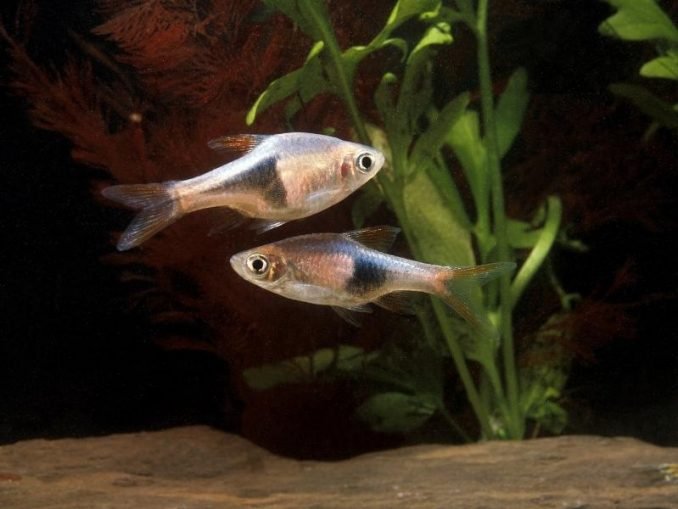
Rasboras belong to a group of small, freshwater fish native to Asia. They come in various species, with the Harlequin Rasbora being one of the most popular. Beyond their vibrant colors, observing their behavior can tell you a lot about their well-being and happiness. So, let’s dive deeper into what makes Rasboras tick, what behaviors to watch for, and how these signals can guide you in creating the best possible environment for them.
Why Do Rasboras School Together?
One of the most captivating aspects of Rasbora behavior is their tendency to school. You might wonder why these fish prefer to swim in groups rather than alone. Well, schooling is a natural instinct for many fish species and serves a couple of important purposes.
First, being in a school provides safety in numbers. Just like a flock of birds can fend off predators by sticking together, Rasboras find protection when they swim as a group. It’s easier for them to evade larger fish or other threats in the wild. This instinct continues even in captivity, which means your Rasboras will feel more secure and thrive when kept in groups of at least five to six.
Another reason they school is due to their social nature. Rasboras are not solitary fish; they enjoy the company of their own kind. Seeing them swim together in harmony creates a stunning visual spectacle. If your fish are frequently separating or hiding, it could signal stress or discomfort in their environment.
Understanding Aggression in Rasboras
Rasboras are generally peaceful fish, but like any living creature, they can exhibit some aggressive behaviors, especially if they’re feeling threatened or overcrowded. If you notice fin nipping or persistent chasing, it’s essential to take a closer look at their environment.
Stress is often the root cause of aggression. Are your Rasboras in a tank that’s too small? Is there enough hiding space provided by plants or decorations? If they’re feeling cramped, it might lead to skirmishes among them. To alleviate this, consider increasing the tank size or adding more decorations.
Another factor to consider is their tank mates. While Rasboras usually get along well with other peaceful species, introducing more aggressive fish can create tension. It’s all about finding the right balance in your aquarium.
Feeding Behavior: What You Should Know
Feeding time can be an exciting event for your Rasboras. Their behavior during meals can reveal much about their health and happiness. When they’re eager to eat, you’ll often see them darting and swimming energetically, almost like they’re dancing in anticipation.
However, if your fish seem disinterested or are ignoring food, it might indicate a problem. A sudden lack of appetite can be a sign of stress, illness, or a poor water quality. It’s essential to keep a close eye on their eating habits. Make sure you’re offering varied foods, like flakes, pellets, or live food, to keep their interest piqued.
Also, don’t forget about the importance of feeding amount and frequency. Overfeeding can lead to water quality issues and health problems, while underfeeding can stress your fish out. Striking the right balance will keep your Rasboras content and healthy.
The Importance of Water Quality on Behaviors
Water quality plays a crucial role in the behavior of Rasboras. These fish are quite sensitive to changes in their environment, and poor water conditions can lead to stress and behavioral issues.
For instance, high ammonia levels can cause your fish to become lethargic or hide more often. Ideally, you want to maintain stable water parameters, including temperature, pH, and hardness. Regular water changes and good filtration can help keep the habitat healthy.
You might also want to consider investing in a water testing kit. This tool will make it easier to monitor and adjust your tank conditions as needed. When they’re swimming happily and exploring their space, that’s when you’ll know you’re on the right track.
Identifying Signs of Stress in Rasboras
Knowing how to spot stress signals in your Rasboras is key to ensuring their well-being. Some common signs include unusual swimming patterns, loss of color, or excessive hiding. If your fish seem skittish or are frequently darting away at the slightest disturbance, they’re likely feeling stressed.
Another red flag is if they begin to breathe rapidly, as this could indicate that they are not getting enough oxygen or experiencing poor water quality. If you see these indicators, it may be time to re-evaluate their environment.
Creating a calm and enriched habitat can significantly reduce stress. Consider adding more plants, hiding spots, or even dimming the lights a bit if they seem too jumpy.
Rasbora Breeding Behavior
If you’re lucky enough to have a healthy group of Rasboras, you might witness some interesting breeding behavior. When they’re ready to spawn, males often display vibrant colors and engage in elaborate courtship rituals to attract females. You might notice them swimming in circles or chasing one another around the tank.
Breeding can be exciting to observe, but it also comes with its challenges. Make sure to provide plenty of plant cover for the eggs. Rasboras tend to scatter their eggs among plants, and if there aren’t enough safe spots, they might become snacks for the adults! If you’re not prepared to handle fry, consider separating the parents during this time to prevent them from eating their young.
Providing the right conditions, like slightly warmer water and more frequent water changes, can encourage successful breeding. Just keep in mind that while watching Rasboras breed can be thrilling, it’s also a commitment.
Understanding the behavior of your Rasboras not only enhances your experience as an aquarium keeper, but it also helps ensure a happy and healthy environment for your fish. By observing their schooling habits, feeding behaviors, and stress signals, you’ll foster a thriving community in your tank.
Remember, each Rasbora is a unique little personality, and getting to know them can be incredibly rewarding. With proper care and attention to their behaviors, you’ll create an aquarium that’s not just a home for your fish, but a beautiful and lively ecosystem. Keep an eye on those little swimmers, and enjoy every moment of your underwater adventure!

